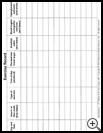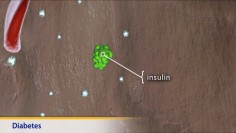
Diabetes and Exercise: Preventing Low Blood Sugar
Blood sugar levels can go up and down when your child exercises. This can be frustrating. But it is important to exercise to help keep the heart and blood vessels healthy. You and your child can avoid problems if you keep good records of exercise and blood sugar.
How does exercise affect blood sugar levels?
Exercise usually helps lower your child's blood sugar. Insulin is more effective during and after exercise. Research has shown that after 1 hour of afternoon exercise, blood sugars will stay lower until the next morning. The body is more sensitive to insulin and the insulin can work more efficiently. This means a lower daily dose is needed. Exercise can be a very good way to lower a high blood sugar (as long as ketones are not present).
Sometimes blood sugars go up with exercise. This may be because your child is excited and is releasing a hormone called adrenaline. This is normal whether or not you have diabetes. The adrenaline causes sugar to be released from stores in the muscle and liver and raises the blood sugar for awhile. This usually happens in the first hour of exercise.
How can I help prevent low blood sugar reactions during exercise?
Check blood sugars before, during, and after the exercise.
The best way to know how exercise affects your child is to check blood sugars before, during, and after the exercise. If blood sugar drops during or after exercise, your child needs to eat extra snacks. When this happens, test your child’s blood sugar every 15 minutes until the blood sugar is in the normal range.
Keeping good records is important. That way, a similar exercise done at a similar time of day with a similar starting blood sugar level will help you know how to adjust insulin and snacks.
Eat before heavy exercise.
If your child is going to exercise around mealtime, your child should eat the meal first. It is best to eat a meal or snack with carbohydrates 1 to 3 hours before exercise.
- Liquids are absorbed most rapidly. They generally prevent low blood sugar reactions for the next 30 to 60 minutes.
- Solid foods are digested more slowly. They usually keep the blood sugar level up for at least 2 to 3 hours.
Have extra snacks handy during exercise.
Your child must always have a source of sugar handy.
- You can sew pockets in basketball shorts, jogging pants, and other clothes to hold a sugar packet, sugar cube, or a glucose tablet for an emergency. Joggers' wallets on shoes work well.
- Keep a sandwich or other snack nearby, as a sugar packet may last only a few minutes.
- It is helpful for the coach or teacher to have a tube of instant glucose or some other emergency source of sugar.
It is not always easy to guess the amount of a snack needed for every activity. If the exercise is in the hour after a meal, your child may not need an extra snack. If your child is not physically fit, the blood sugar may drop faster than for a child who is physically fit. Keep track of the blood sugar to figure out what the correct snack is for your child. If the blood sugar is:
- below 90 mg/dL and dropping, your child may need extra calories.
- 90 to 270 mg/dL, extra calories may not be needed. It depends on how long your child exercises and how exercise affects your child’s blood sugar.
- over 270 mg/dL and urine or blood ketones are present (over 0.5 mmol/L), it is best to delay exercise until levels are back to normal.
The type of snack depends on how long the activity is expected to last.
- Snacks such as milk or juice are used for short-term (30 to 60 minutes) activities. These snacks are carbs that are quickly absorbed. Add more food, such as crackers or bread, if the activity is to last longer.
- Snacks that include protein and fat along with carbs are good for long-term activities. This might be a cheese or meat sandwich with a glass of juice.
It is a good idea to keep packets of cheese and crackers in the glove box of your car for your child to eat before or after an activity. This is very important if the distance is far between home and the activity.
It is wise to check the blood sugar after the activity to help decide what to use for a snack the next time.
Extra water is also important, especially in hot weather. A general rule is to drink 8 ounces of fluid for every 30 minutes of vigorous activity. Liquids such as milk, Gatorade, and fruit juices help replace water, salts, and carbs.
Reduce the insulin dosage.
Before trying an activity for the first time, ask your diabetes care provider what changes might be needed in insulin dosage. The insulin dose is easy to decrease if you know which insulin is having its main effect during the time of exercise. Your child should reduce the insulin that is most active during the period of heavy exercise. People reduce insulin by different amounts.
If extra morning exercise is planned, you can reduce or leave out the morning Humalog, NovoLog, Apidra, or Regular insulin. If late afternoon exercise is planned, you can reduce the morning insulin by 10% to 50%. NPH insulin is usually not left out entirely. The rapid-acting insulin at dinner may be reduced by a few units when heavy exercise is to occur after dinner.
For example: If your child gets 30 units of NPH insulin in the morning and he has a soccer game in the afternoon, you might reduce the dose by 10% to 20% (3 to 6 units). He would then receive 24 to 27 units of NPH insulin.
If heavy exercise is planned for the whole day, the morning NPH, the Lantus or Levemir, and the rapid-acting insulins can all be reduced. The evening insulin dose may also need to be reduced to prevent a delayed low blood sugar reaction.
If heavy exercise is planned for the evening, the dinner rapid-acting insulin or Regular insulin can be reduced or not given. If your child stays up later than usual for a sleepover at a friends' home, the evening NPH, Levemir, or Lantus might be decreased. More activity and excitement burn more sugar, and less insulin may be needed.
Reduction of insulin dosage with exercise is easiest when the child uses an insulin pump. The basal insulin dose can be reduced, or if exercise is strenuous, the pump can be removed. A further reduction from 9 PM to 3 AM may help to prevent delayed hypoglycemia.
You may have to try a few times before you find the best way to reduce the insulin for your child's activities. Keep careful records and discuss them at clinic visits. Blood sugar tests before and after exercise can help you make these decisions.
Change the injection site.
Where you inject the insulin can help prevent low blood sugar. Exercise increases blood flow into the part of the body that is moving. The increased blood flow takes up more insulin.
- If you inject insulin into an arm or leg that will be used heavily during exercise, your child's body may absorb the insulin too fast. If your child is going to run, don't inject insulin into the leg. If your child is going to play tennis, do not inject into the tennis arm.
- The abdomen is a good site for most exercise days.
Temperature can make a difference.
- High temperature tends to spread insulin more rapidly through the body. If sports activities are done outdoors on a hot day, there may be a higher risk of low blood sugar.
- Low temperature tends to decrease insulin absorption. Keep this in mind if your child exercises outdoors on a cold day.
- Results of blood glucose meters may not be accurate in extreme temperatures.
- If your child exercises at high altitudes, symptoms of low blood sugar may be confused with those of altitude sickness.
Make sure others know.
It is important that coaches and teammates know about your child's diabetes. A team manager may be able to carry extra sugar snacks. It helps if the coach knows about the diabetes and knows the symptoms and treatment of low blood sugar. The coach should know if a child has low blood sugar during a sporting event, the child needs to rest for at least 10 minutes to let the blood sugar rise. Your child should wear some form of ID stating that he is a diabetic (such as a Medic Alert bracelet).
What is delayed hypoglycemia?
Delayed hypoglycemia means your child has low blood sugars several hours after the exercise is over. It may occur 3 to 4 hours or up to 12 hours after exercise. This can sometimes cause an insulin reaction in the middle of the night. It may happen because extra sugar in the blood goes back into storage in the muscle. Hormone changes with sleep (such as lower adrenaline levels) may also cause the delayed reaction. It is best prevented by:
- Eating extra carbohydrate at the next meal or snack (even when the blood sugar is above-range)
- Eating a longer-lasting snack (including solid carbohydrate, protein, and fat) at bedtime
- Reducing the insulin dose.
If your child is having this problem, talk with your healthcare provider.
Last modified: 2011-06-29
Last reviewed: 2011-05-10


